|
Onondaga Historical Museum - Permanent Exhibits |
|
| |
Trip Advisor
Take a Virtual Tour of our Heart of New York Exhibition, Underground Railroad Exhibition, Syracuse China Exhibition, The Marsellus Gallery and Gift Gallery, from Google.
Backroom Tours
"Behind the Scenes Tour" of OHA's Syracuse China Collection In addition to our regular Syracuse China permanent exhibit, OHA now offers a weekly "Behind the Scenes" tour of the extended collection of Syracuse China. The Syracuse China "Behind the Scenes" tour is every Wednesday at the Museum, from 11 AM to 12 PM. Tickets are $10 per person. Private tours of 10 -15 can also be arranged. Please call 428-1864 ext. 312 for more information and reservations.
Part of our backroom tour—The Jean Daugherty Memorial Magic Toy Shop
Collection The Magic Toy Shop was the most beloved children’s television show in Syracuse running from 1955 to 1982. OHA has the definitive collection (props, toys, costumes, etc.) from the show, along with the television camera used to film it. We are in the process of creating a new permanent exhibition and storage room from these items and the rest of the toy collection, as part of our backroom tour.
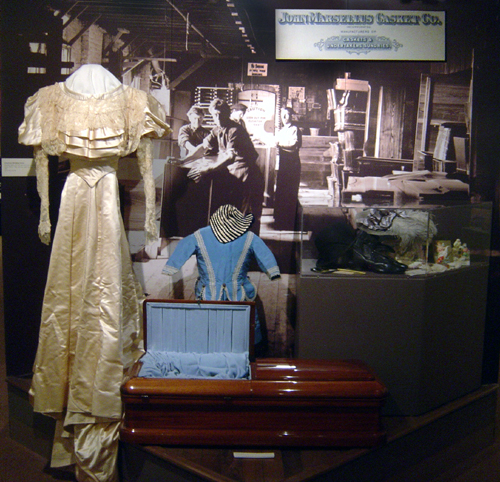 Onondaga County: The Heart of New York Onondaga County: The Heart of New York
Onondaga County: The Heart of New York consists of five major theme areas.
The first is Birth of a County, tracing the settlement of central New York and the formation of OnondagaCounty, the 19 towns within the county, and the city of Syracuse.
Power of the People salutes individuals who make up our county, from the original - and current - Native American inhabitants to the newest immigrant groups. This section also discusses abolition and the Jerry Rescue, Onondaga County's citizens serving their country in time of war, the women's suffrage movement and notable local activists, and 19th century recreation and entertainment
Crossroads of New York addresses the different modes of transportation once used in Onondaga County. From water transportation on the Erie Canal, to land transportation via trolleys, railroads and automobiles, to air transportation, each system has made important contributions to the growth and sustenance of Onondaga County. An interactive feature of the transportation segment is a locomotive bell from the last train to pass through Syracuse inthe1930s.
 Architecturally Speaking highlights the changing architectural scene of Onondaga County throught landmarks, past and present. This section presents a photographic array of private and public buildings, some still extant and others that have perished in the path of the wrecking ball. Located in this section is a flip-book titled, Do You Know These Buildings? To further familiarize visitors with local architecture, the flip-book asks visitors to identify 8 buildings located near the museum. Architecturally Speaking highlights the changing architectural scene of Onondaga County throught landmarks, past and present. This section presents a photographic array of private and public buildings, some still extant and others that have perished in the path of the wrecking ball. Located in this section is a flip-book titled, Do You Know These Buildings? To further familiarize visitors with local architecture, the flip-book asks visitors to identify 8 buildings located near the museum.
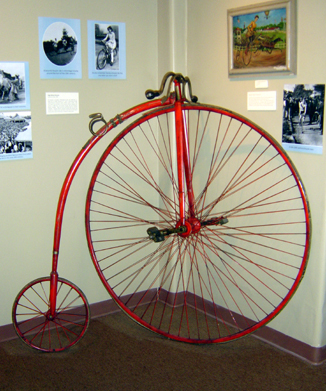 The final exhibit topic, Making A Living, discusses agriculture, business, industry, labor, and services in Onondaga County. Featured are examples of locally-made products such as Camillus Cutlery, T.C. Timber wooden toys, Marsellus caskets, and typewriters. In this section, visitors can type on a vintage typewriter, comparing it to today's computer keyboard. The final exhibit topic, Making A Living, discusses agriculture, business, industry, labor, and services in Onondaga County. Featured are examples of locally-made products such as Camillus Cutlery, T.C. Timber wooden toys, Marsellus caskets, and typewriters. In this section, visitors can type on a vintage typewriter, comparing it to today's computer keyboard.
As visitors leave the exhibit a final panel, Writing the Next Chapter reminds visitors that history is on-going and is created every day. The Onondaga Historical Association Museum & Research Center plays a vital role in preserving the written, oral and material history of Onondaga County. As the oldest historical agency in Onondaga County, OHA is dedicated to collecting artifacts and information that document and perpetuate our community's heritage. |
| |
|
|
|
Freedom Bound: Syracuse & the Underground Railroad
Dedicated to the history of anti-slavery and Underground Railroad activity in Onondaga County
First Floor, East Gallery - permanent exhibition
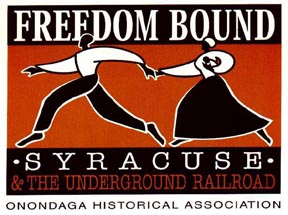 On September 13, 2003 OHA opened a major new permanent exhibit on the history of Anti-Slavery and Underground Railroad Activity in Onondaga County. This exhibition features three of the seven carved faces recovered from the basement of Syracuse's 1846 Wesleyan Methodist Church, which relate to the dramatic story of fugitive slaves seeking their freedom. The exhibit personalizes the story of the Underground Railroad while educating visitors about slavery, abolitionism, tolerance and the meaning of freedom. Through a highly immersive experience, the exhibit re-creates the story of how slaves had to make the decision to escape, leaving behind family and the only world they knew, for a chance at freedom. The story of an actual group of fugitives who sought safety in Syracuse and the local citizens who both supported and opposed them is explored using actual writings of the protagonists. This is a wonderful story illustrating the courage and determination of these fugitives led by a man named Frank Wanzer who actually had to fight their way out of Virginia to escape the slave catchers. It also is a family story that tells of Wanzer's marriage to Emily Foster in the parlor of Reverend Jermain Loguen's home. It illustrates the courage and commitment of local Syracusans who risked everything to do what they believed On September 13, 2003 OHA opened a major new permanent exhibit on the history of Anti-Slavery and Underground Railroad Activity in Onondaga County. This exhibition features three of the seven carved faces recovered from the basement of Syracuse's 1846 Wesleyan Methodist Church, which relate to the dramatic story of fugitive slaves seeking their freedom. The exhibit personalizes the story of the Underground Railroad while educating visitors about slavery, abolitionism, tolerance and the meaning of freedom. Through a highly immersive experience, the exhibit re-creates the story of how slaves had to make the decision to escape, leaving behind family and the only world they knew, for a chance at freedom. The story of an actual group of fugitives who sought safety in Syracuse and the local citizens who both supported and opposed them is explored using actual writings of the protagonists. This is a wonderful story illustrating the courage and determination of these fugitives led by a man named Frank Wanzer who actually had to fight their way out of Virginia to escape the slave catchers. It also is a family story that tells of Wanzer's marriage to Emily Foster in the parlor of Reverend Jermain Loguen's home. It illustrates the courage and commitment of local Syracusans who risked everything to do what they believed 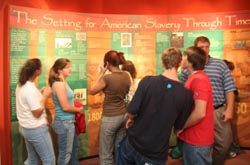 was right. People will meet local individuals like Syracuse stationmaster Reverend (later Bishop) Jermain Loguen of the AME Zion Church, abolitionist leader Gerrit Smith, freedom seeker Harriet Powell and anti-abolitionist B. Davis Noxon. Life-size cutouts, special visual effects and audio dialogue periodically transform the gallery from a visually appealing exhibition into a provocative object theater where visitors experience a dramatic audio and light projection program. The gallery comes alive with the images, voices and music of this period. The faces from the Wesleyan Methodist Church give voice to serve as dramatic symbols for the narrative. Visitors are able to leave their thoughts about what the faces "say " to them today and these reactions will be incorporated into the exhibit as part of this timeless story. The exhibit also interprets the character of the African-American community in the Syracuse area up through the was right. People will meet local individuals like Syracuse stationmaster Reverend (later Bishop) Jermain Loguen of the AME Zion Church, abolitionist leader Gerrit Smith, freedom seeker Harriet Powell and anti-abolitionist B. Davis Noxon. Life-size cutouts, special visual effects and audio dialogue periodically transform the gallery from a visually appealing exhibition into a provocative object theater where visitors experience a dramatic audio and light projection program. The gallery comes alive with the images, voices and music of this period. The faces from the Wesleyan Methodist Church give voice to serve as dramatic symbols for the narrative. Visitors are able to leave their thoughts about what the faces "say " to them today and these reactions will be incorporated into the exhibit as part of this timeless story. The exhibit also interprets the character of the African-American community in the Syracuse area up through the  Civil War and helps people understand the vital role this group played in the success of local Underground Railroad activities. Civil War and helps people understand the vital role this group played in the success of local Underground Railroad activities.
The exhibit provides intriguing insights appealing to local citizens of diverse ethnic and racial backgrounds. The subject resonates deeply within the local African-American community. Not only will the exhibit confront this group's long journey to achieve full citizenship, but also it will expose thousands of visitors to the profound yet often overlooked early history of local African-Americans.
Please click here to view visitor comments.
The Jerry Rescue
Simultaneous to opening the new Freedom Bound: Syracuse and the Underground Railroad exhibit, OHA unveiled a dramatic, first-person video interpretation of the watershed Jerry Rescue of 1851, a Syracuse anti-slavery event that resounded throughout the country, even inside the very walls of the White House. This dramatic presentation is told through the person of Lucy Watkins as interviewed by a reporter of the Syracuse Standard in the 1890's. Lucy recalls the events that led up to the rescue in flashbacks based on her own recollections and the first person story told her by William "Jerry" Henry himself when he was brought to her home after the rescue to have his manacles removed. These she buried in her backyard; they survive today and are on display in the new exhibit. |
 Transportation Exhibit Transportation Exhibit
Story of the once-grand Franklin company (1902-1934) and local transportation history on display
Main Lobby Gallery - permanent exhibition
Come see the exhibit chronicling the history of the Franklin automobile company! From its beginnings in 1902 until its demise in 1934, Franklin was one of Syracuse's largest industrial concerns once employing as many as 5,000 persons!
The most comprehensive interpretation of this famous manufacturer features the first Franklin automobile sold by the company. The 1902 Franklin light roadster on exhibit is resplendent with its green and red coachwork, black fenders and leather seats! The car turned 100 years old in 2002 and is on long-term loan from the Museum of American History, Smithsonian Institution in Washington, DC. Historic photos of the Franklin factory, automobiles, and employees, as well as brochures, a 1924 styling model of a Franklin sedan, and vintage driving attire are also on display.


|
Syracuse China: Fired Forms of the American Experience
Come see the cupman, WW II ceramic land mine, railroad & airplane china, and many other items on display!
Syracuse China Gallery, 2nd floor - permanent exhibition
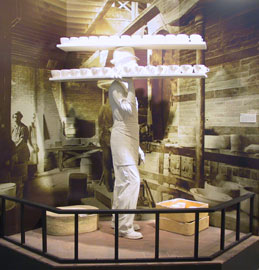 For well over a century, the dinnerware produced by the Syracuse China company has reflected the ever evolving lifestyles of America. In its permanent exhibit on Onondaga Pottery and Syracuse China the OHA’s downtown Syracuse museum features nearly 200 examples of china made by the Syracuse China company, spanning a 130-year period. Accompanied by dozens of historical photographs, advertisements, and period graphics, the exhibition presents the captivating story of a Central New York company whose product became admired and heavily used across the nation. For well over a century, the dinnerware produced by the Syracuse China company has reflected the ever evolving lifestyles of America. In its permanent exhibit on Onondaga Pottery and Syracuse China the OHA’s downtown Syracuse museum features nearly 200 examples of china made by the Syracuse China company, spanning a 130-year period. Accompanied by dozens of historical photographs, advertisements, and period graphics, the exhibition presents the captivating story of a Central New York company whose product became admired and heavily used across the nation.
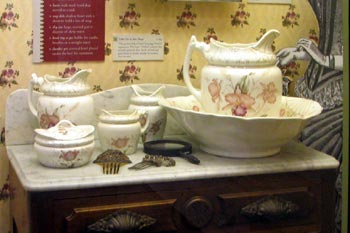 Syracuse China has been a vital part of ornate hotel banquet rooms, roadside cafes, private clubs, elegant mansion dining rooms, suburban backyards, countless railroad dining cars, ocean-going ships, naval aircraft carriers and refined tea rooms. It can be found in locations that stretch from the governor’s mansion in Maine to the landmark Hotel del Coronado in Southern California. Examining the china and learning the stories of its decorations, shapes and marketing provides an intriguing look into America’s growth and dining habits. Syracuse China has been a vital part of ornate hotel banquet rooms, roadside cafes, private clubs, elegant mansion dining rooms, suburban backyards, countless railroad dining cars, ocean-going ships, naval aircraft carriers and refined tea rooms. It can be found in locations that stretch from the governor’s mansion in Maine to the landmark Hotel del Coronado in Southern California. Examining the china and learning the stories of its decorations, shapes and marketing provides an intriguing look into America’s growth and dining habits.
Just a few of the pieces on display include an example of the company’s breakthrough Imperial Geddo ware, which won a prize at the 1893 World Colombian Exposition in Chicago; a 1910 plate used on a private car of the Empire State Railroad; an Arts and Crafts style serving dish with a pattern called "Indian;" a plate from the New York Central’s streamlined Mercury train, designed by Henry Dreyfus; and the exclusive Airlite shape developed for American Airlines in the late 1940’s.
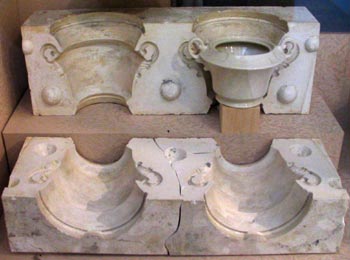 The exhibit also contains a cup and saucer in the Wellington line, the last fine china shape produced before the company ended the household side of their business in 1970. Intense foreign competition, following World War II, and changes in America’s lifestyle in the 1950’s and 1960’s conspired to make the production of household china an unprofitable portion of the business. The exhibit also contains a cup and saucer in the Wellington line, the last fine china shape produced before the company ended the household side of their business in 1970. Intense foreign competition, following World War II, and changes in America’s lifestyle in the 1950’s and 1960’s conspired to make the production of household china an unprofitable portion of the business.
To help communicate the rich history, the exhibit includes a life-size reproduction of a pottery worker, about 1920, carrying rows of cups to the kiln for firing. Large murals convey visitors to the inside of the company’s clay shop in 1910 and to the aisle of a 1930 Union Pacific Railroad dining car. One television monitor plays rare movie footage of the factory’s interior during the 1920’s, showing some of the several steps in making fine china. Another presents movies that capture the elegance of railroad dining in the 1930’s. Hands-on activities include a game to match custom designs with the dining spot where they were used and a push button quiz to guess which plate is true china.
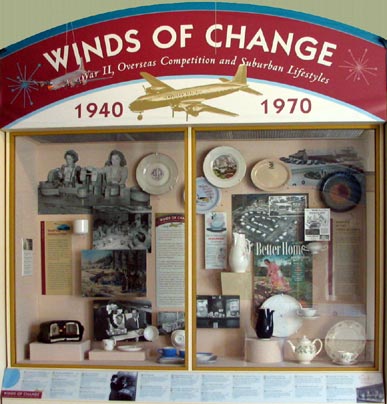 To convey the breadth of the Syracuse China story, OHA secured historic from collections across the country including Mystic Seaport Museum in Connecticut, the Western Heritage Center in Montana, the Western Reserve Historical Society in Ohio and the University of Baltimore in Maryland. To convey the breadth of the Syracuse China story, OHA secured historic from collections across the country including Mystic Seaport Museum in Connecticut, the Western Heritage Center in Montana, the Western Reserve Historical Society in Ohio and the University of Baltimore in Maryland.
The exhibit also chronicles the specific history of the Syracuse China Company, which started in 1871 as the Onondaga Pottery Company but can trace its roots back to the small Geddes, New York pottery of Williams Farrar, founded in 1841. Through the ceramic skills and manufacturing vision of James Pass, the company was expanded from a small local pottery into a national leader in the design and production of dinnerware. This was due, in large measure, to Pass’ development of America’s first true vitreous china in 1888. This was the highest grade of china ware, previously the domain of European potteries. Today, Syracuse China is owned by Libbey, Inc. of Toledo, Ohio, a national corporation serving the American dining industry.
The exhibit was made possible through the encouragement of Syracuse China and Libbey officials who made the company’s vast archives completely accessible to the exhibit’s curator, Dennis J. Connors, OHA’s own curator of history.
A tremendous resource for the company’s history was the 1997 Syracuse University publication, Syracuse China. Its authors included Syracuse China archivist, Cleota Reed, and long -time company employee and historian, Stan Skoczen. Both helped as advisors to the exhibit, along with Ruth Pass Hancock, the granddaughter of James Pass.
|
Syracuse's Brewing History
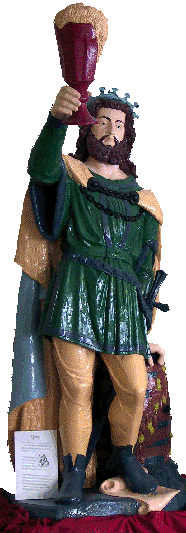
A small display of interesting artifacts of the Brewing History in Syracuse is on exhibit on the 2nd floor of the museum. |
|
| |
|